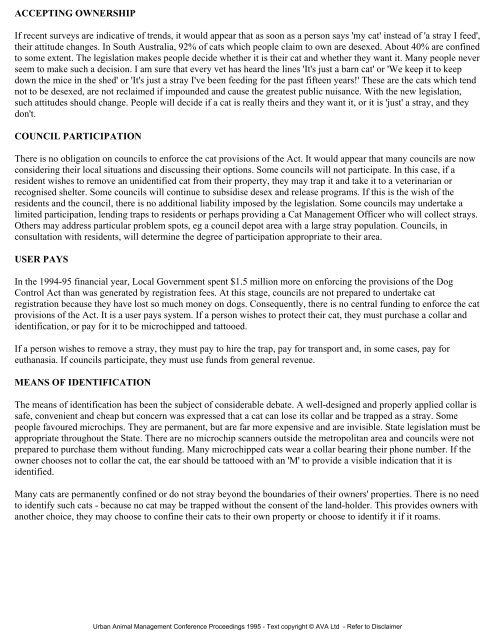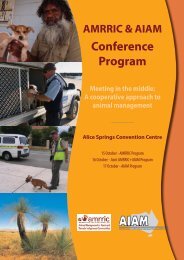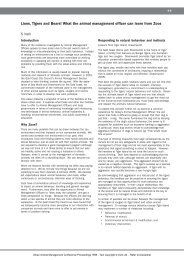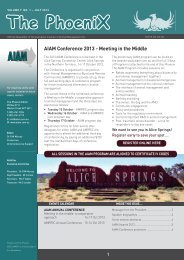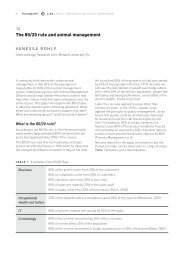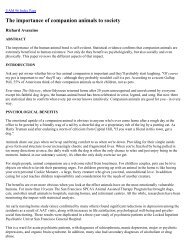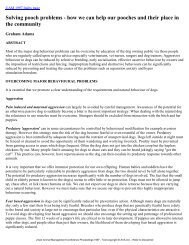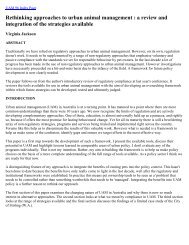Cat legislation in South Australia - Australian Institute of Animal ...
Cat legislation in South Australia - Australian Institute of Animal ...
Cat legislation in South Australia - Australian Institute of Animal ...
Create successful ePaper yourself
Turn your PDF publications into a flip-book with our unique Google optimized e-Paper software.
ACCEPTING OWNERSHIP<br />
If recent surveys are <strong>in</strong>dicative <strong>of</strong> trends, it would appear that as soon as a person says 'my cat' <strong>in</strong>stead <strong>of</strong> 'a stray I feed',<br />
their attitude changes. In <strong>South</strong> <strong>Australia</strong>, 92% <strong>of</strong> cats which people claim to own are desexed. About 40% are conf<strong>in</strong>ed<br />
to some extent. The <strong>legislation</strong> makes people decide whether it is their cat and whether they want it. Many people never<br />
seem to make such a decision. I am sure that every vet has heard the l<strong>in</strong>es 'It's just a barn cat' or 'We keep it to keep<br />
down the mice <strong>in</strong> the shed' or 'It's just a stray I've been feed<strong>in</strong>g for the past fifteen years!' These are the cats which tend<br />
not to be desexed, are not reclaimed if impounded and cause the greatest public nuisance. With the new <strong>legislation</strong>,<br />
such attitudes should change. People will decide if a cat is really theirs and they want it, or it is 'just' a stray, and they<br />
don't.<br />
COUNCIL PARTICIPATION<br />
There is no obligation on councils to enforce the cat provisions <strong>of</strong> the Act. It would appear that many councils are now<br />
consider<strong>in</strong>g their local situations and discuss<strong>in</strong>g their options. Some councils will not participate. In this case, if a<br />
resident wishes to remove an unidentified cat from their property, they may trap it and take it to a veter<strong>in</strong>arian or<br />
recognised shelter. Some councils will cont<strong>in</strong>ue to subsidise desex and release programs. If this is the wish <strong>of</strong> the<br />
residents and the council, there is no additional liability imposed by the <strong>legislation</strong>. Some councils may undertake a<br />
limited participation, lend<strong>in</strong>g traps to residents or perhaps provid<strong>in</strong>g a <strong>Cat</strong> Management Officer who will collect strays.<br />
Others may address particular problem spots, eg a council depot area with a large stray population. Councils, <strong>in</strong><br />
consultation with residents, will determ<strong>in</strong>e the degree <strong>of</strong> participation appropriate to their area.<br />
USER PAYS<br />
In the 1994-95 f<strong>in</strong>ancial year, Local Government spent $1.5 million more on enforc<strong>in</strong>g the provisions <strong>of</strong> the Dog<br />
Control Act than was generated by registration fees. At this stage, councils are not prepared to undertake cat<br />
registration because they have lost so much money on dogs. Consequently, there is no central fund<strong>in</strong>g to enforce the cat<br />
provisions <strong>of</strong> the Act. It is a user pays system. If a person wishes to protect their cat, they must purchase a collar and<br />
identification, or pay for it to be microchipped and tattooed.<br />
If a person wishes to remove a stray, they must pay to hire the trap, pay for transport and, <strong>in</strong> some cases, pay for<br />
euthanasia. If councils participate, they must use funds from general revenue.<br />
MEANS OF IDENTIFICATION<br />
The means <strong>of</strong> identification has been the subject <strong>of</strong> considerable debate. A well-designed and properly applied collar is<br />
safe, convenient and cheap but concern was expressed that a cat can lose its collar and be trapped as a stray. Some<br />
people favoured microchips. They are permanent, but are far more expensive and are <strong>in</strong>visible. State <strong>legislation</strong> must be<br />
appropriate throughout the State. There are no microchip scanners outside the metropolitan area and councils were not<br />
prepared to purchase them without fund<strong>in</strong>g. Many microchipped cats wear a collar bear<strong>in</strong>g their phone number. If the<br />
owner chooses not to collar the cat, the ear should be tattooed with an 'M' to provide a visible <strong>in</strong>dication that it is<br />
identified.<br />
Many cats are permanently conf<strong>in</strong>ed or do not stray beyond the boundaries <strong>of</strong> their owners' properties. There is no need<br />
to identify such cats - because no cat may be trapped without the consent <strong>of</strong> the land-holder. This provides owners with<br />
another choice, they may choose to conf<strong>in</strong>e their cats to their own property or choose to identify it if it roams.<br />
Urban <strong>Animal</strong> Management Conference Proceed<strong>in</strong>gs 1995 - Text copyright © AVA Ltd - Refer to Disclaimer


